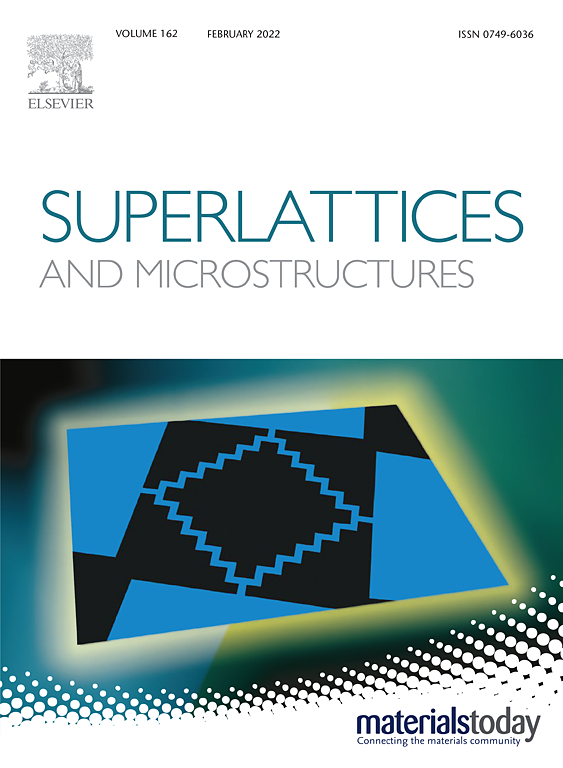Near-room-temperature reversible switching of quadratic optical nonlinearities in a one-dimensional perovskite-like hybrid
IF 3.3
3区 物理与天体物理
Q2 PHYSICS, CONDENSED MATTER
引用次数: 2
Abstract
The switching of quadratic nonlinear optical (NLO) effects between two or more NLO states of solid-state materials represents an intriguing new branch in the field of photoelectrics and optics. While structural phase transitions have shown potential in this field, near-room-temperature reversible NLO switches have rarely been reported. To exploit new NLO switching materials within the structurally flexible class of hybrid perovskites, here, we synthesize a one-dimensional perovskite-like hybrid, (MP)PbBr3 (where MP+ is a 1-methylpyrrolidinium cation), through a facile solution method, which exhibits strong second harmonic generation (SHG) activities with an intensity of ~1.6 times as large as potassium dihydrogen phosphate. Intriguingly, (MP)PbBr3 enables the near-room temperature reversible switching of SHG properties, showing a large NLO switching contrast of up to ~40 between its SHG-active and SHG-inactive phases, beyond most of its liquid counterparts. Further microscopic structural analyses reveal that the dynamic ordering of the organic MP+ cation and inorganic chain-like skeleton triggers its centrosymmetric (P63/mmc) to acentric (P212121) phase transition at 316 K upon cooling, resulting in a crucial contribution to its NLO switching properties. This work illustrates the potential of this material as a candidate for solid-state NLO switches and will promote the development of NLO materials within the family of low-dimensional hybrid perovskites.一维钙钛矿类杂化材料中二次光学非线性的近室温可逆开关
二次非线性光学(NLO)效应在固态材料的两个或多个NLO态之间的切换是光电光学领域一个有趣的新分支。虽然结构相变在该领域显示出潜力,但近室温可逆NLO开关很少被报道。为了在结构灵活的杂化钙钛矿中开发新的NLO开关材料,本文通过易溶法合成了一维类钙钛矿杂化物(MP)PbBr3(其中MP+是1-甲基吡啶鎓离子),该杂化物具有强的二次谐波生成(SHG)活性,强度约为磷酸二氢钾的1.6倍。有趣的是,(MP)PbBr3能够实现近室温下SHG性质的可逆切换,在其SHG活性相和SHG非活性相之间显示出高达~40的NLO切换对比度,超过了大多数液体对应物。进一步的微观结构分析表明,有机MP+阳离子和无机链状骨架的动态排序触发了其中心对称(P63/mmc)到非中心(P212121)的相变,导致其NLO开关性能的关键贡献。这项工作说明了这种材料作为固态NLO开关的候选材料的潜力,并将促进低维混合钙钛矿家族中NLO材料的发展。
本文章由计算机程序翻译,如有差异,请以英文原文为准。
求助全文
约1分钟内获得全文
求助全文
来源期刊

Superlattices and Microstructures
物理-物理:凝聚态物理
CiteScore
6.10
自引率
3.20%
发文量
35
审稿时长
2.8 months
期刊介绍:
Superlattices and Microstructures has continued as Micro and Nanostructures. Micro and Nanostructures is a journal disseminating the science and technology of micro-structures and nano-structures in materials and their devices, including individual and collective use of semiconductors, metals and insulators for the exploitation of their unique properties. The journal hosts papers dealing with fundamental and applied experimental research as well as theoretical studies. Fields of interest, including emerging ones, cover:
• Novel micro and nanostructures
• Nanomaterials (nanowires, nanodots, 2D materials ) and devices
• Synthetic heterostructures
• Plasmonics
• Micro and nano-defects in materials (semiconductor, metal and insulators)
• Surfaces and interfaces of thin films
In addition to Research Papers, the journal aims at publishing Topical Reviews providing insights into rapidly evolving or more mature fields. Written by leading researchers in their respective fields, those articles are commissioned by the Editorial Board.
Formerly known as Superlattices and Microstructures, with a 2021 IF of 3.22 and 2021 CiteScore of 5.4
 求助内容:
求助内容: 应助结果提醒方式:
应助结果提醒方式:


